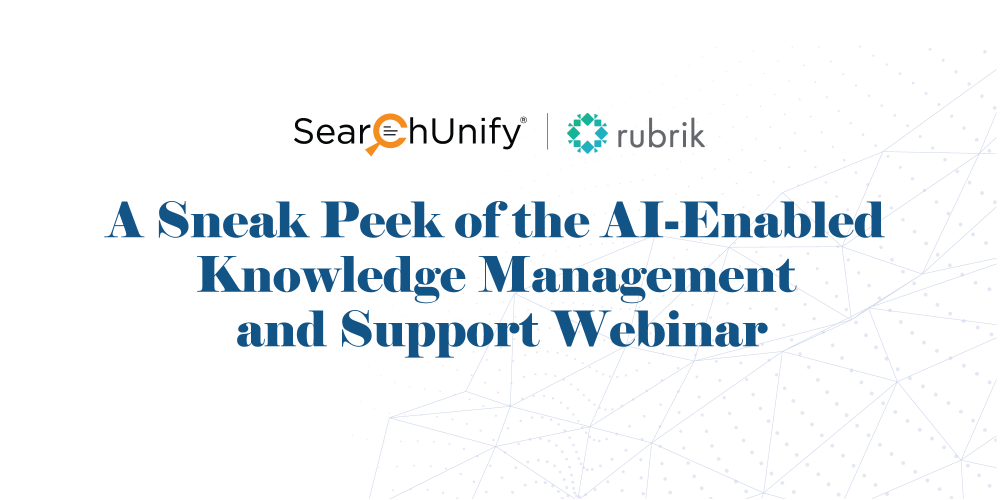

Knowledge management is the process of capturing, distributing, and effectively using knowledge.
– Tom Davenport
The Technology Services Industry Association (TSIA) defines knowledge management as the controlling of facts, lessons, or best practices learned by employees that can be captured to benefit the whole organization.
Although that may sound simple and easy, implementation isn’t definitely a piece of cake. As per TSIA’s Knowledge Management Survey 2019, only 4% of the companies make it to the final strategic phase of the maturity model—let facts speak for themselves.
To help you simplify the execution and assure that even your company completes its KM journey successfully, SearchUnify partnered with Rubrik and conducted a webinar titled AI-Enabled Knowledge Management and Support on July 2nd, 2020. The inquisitive audience of customer support professionals was able to learn the best KM practices from the practitioners who implemented, measured, and improved KM programs and won a Stevie(R) for the best use of technology. Here’s a sneak peek of the key takeaways from the webinar.
Knowledge shared is knowledge squared.
Why is Knowledge Management Difficult?
In the digital age where data continues to grow with each passing day, companies struggle to make knowledge management work. Since knowledge comes in all shapes and sizes, it becomes quite a task to capture and distribute information effectively.
80% of worldwide data will be unstructured by 2025 as per the projections from IDC.
Furthermore, capturing explicit knowledge that comes in the form of product manuals, white papers, research reports, etc. is relatively easier. However, it is the implicit knowledge, and to be precise, tacit knowledge that is difficult to capture and share. Internal individual processes, like experience, reflection, and talent obtain tacit knowledge that is difficult to code. Therefore, the need to capture, organize, and analyze data is as high as challenging it is.
Knowledge Management Maturity Level
To help organizations assess their KM practices, TSIA documented four phases of knowledge management. These phases manifest across people, culture, process, and technology. Besides helping enterprises to self-assess their KM programs, these phases help to identify ways to further improve knowledge sharing. Let’s take a closer look at the phases.
- Recognition Phase: In this phase, barely any formal programs, processes, or metrics related to knowledge management are in place. Companies recognize and reward employees with solutions and answers, which actually promotes knowledge hoarding than knowledge sharing.
- Instantiation Phase: In this phase, processes are identified to capture & share tacit knowledge. Repositories are identified and executives evaluate possible improvements in terms of quality, productivity, and cost if the program succeeds.
- Value Realization Phase: Once the tools and processes are in place, a measurable ROI is identified in this phase. Initial processes are optimized and interest in knowledge management spreads beyond the core team.
- Strategic Phase: In this phase, cross-enterprise knowledge sharing becomes the norm, paving the way for new approaches to staffing and organizational structures. KM initiatives extend throughout the firm and long-term commitments to infrastructure and staffing are provided.
On taking a closer look at the technology section, we see that the need for unified search technology is there at each of these stages. In fact, the need intensifies at each stage. In the first two stages, a search technology with unified interface would suffice whereas, in the later ones, the need for search analytics and insights engine arise to identify the content gaps, usability, relevancy, etc. A cognitive search platform provides you with both of them. Let’s see how Rubrik leveraged cognitive search to amplify its knowledge management and maturity.
Rubrik’s Journey Towards KM Maturity
Rubrik is the leader in cloud data management and helps enterprises achieve data control to drive business resiliency, cloud mobility, and regulatory compliance. It is the fastest-growing enterprise company in the billion-dollar league and has won many accolades for its products and services, including VMWorld Best of Show for two consecutive years in 2017 and 2018, and Forrester Wave Leader for Data Resiliency Solutions in 2019. It also ranked 10th and 21st on LinkedIn Top Startups and Forbes Cloud 100 list respectively.
What challenges did Rubrik face with knowledge management?
As aforementioned, there’s no dearth of data in the digital era. With multiple teams creating and processing data on a day-to-day basis, new and scattered data silos are likely to be produced. This brings us to the core challenge – disparate data silos.
More than often the information we are looking for is buried in the enterprise’s knowledge base. Employees at Rubrik had a hard time switching between diverse channels to find the right information at the right time. Moreover, if they were able to surface information through native search, relevance remained questionable.
Besides relevance of search results, limited support engineer participation and knowledge creation also made employees’ lives harder. This further impeded effective collaborations and the creation of support knowledge articles. Last but not least, multiple content repositories with zilch synchronization resulted in duplication of content and articles.
How did cognitive technology help Rubrik scale its knowledge management?
Rubrik leveraged cognitive technology to improve its knowledge management effectiveness. To learn about Rubrik’s knowledge management maturity journey and how they leveraged cognitive technology at each stage, tune in to our webinar and hear it from the horse’s mouth.